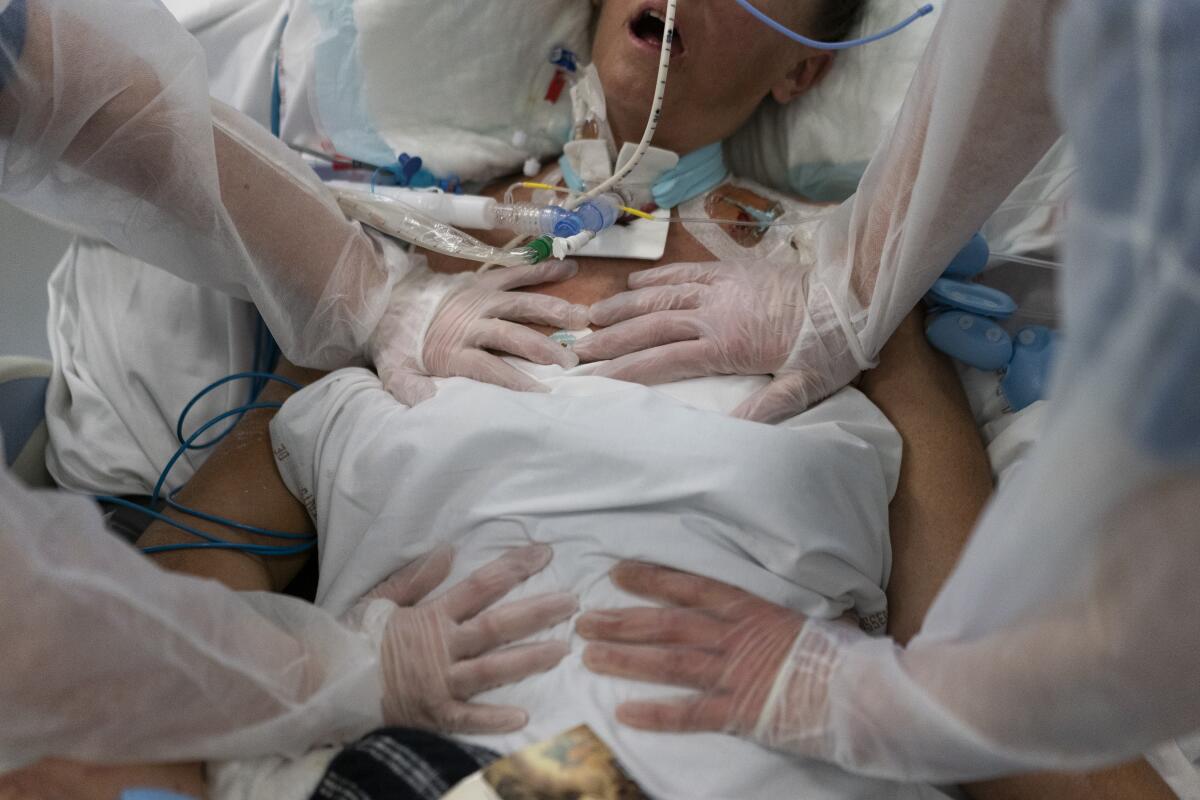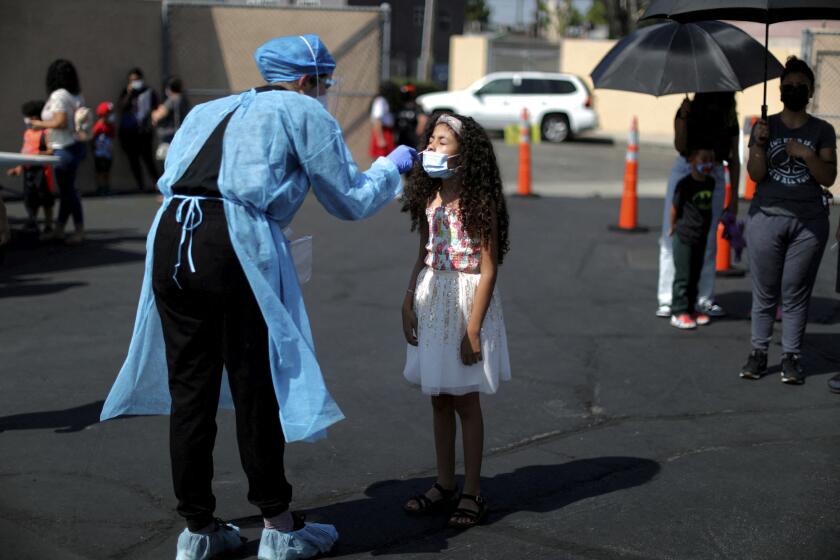COVID-19 has now killed 6 million people as pandemic enters its third year

- Share via
BANGKOK, Thailand — The official global death toll from COVID-19 eclipsed 6 million Monday, underscoring that the pandemic, now entering its third year, is far from over.
The milestone, recorded by Johns Hopkins University, is the latest tragic reminder of the unrelenting nature of the pandemic even as people are shedding masks, travel is resuming and businesses are reopening around the globe.
Remote Pacific islands, whose isolation had protected them for more than two years, are just now grappling with their first outbreaks and deaths, fueled by the highly contagious Omicron variant.
Hong Kong, which is seeing deaths soar, is testing its entire population of 7.5 million three times this month as it clings to mainland China’s zero-tolerance COVID strategy.
As death rates remain high in Poland, Hungary, Romania and other Eastern European countries, the region has seen more than 1.5 million refugees arrive from war-torn Ukraine, a country with poor vaccination coverage and high rates of cases and deaths.
And despite its wealth and vaccine availability, the United States is nearing 1 million reported deaths on its own.
Evusheld can help protect immunocompromised people from COVID, but patients say scant awareness and a complicated process have hampered its rollout.
Death rates worldwide are still highest among people unvaccinated against COVID-19, said Tikki Pang, a visiting professor at the National University of Singapore’s medical school and co-chair of the Asia Pacific Immunization Coalition.
“This is a disease of the unvaccinated. Look [at] what is happening in Hong Kong right now — the health system is being overwhelmed,” said Pang, the former director of research policy and cooperation at the World Health Organization. “The large majority of the deaths and the severe cases are in the unvaccinated, vulnerable segment of the population.”
It took the world seven months to record its first 1 million deaths from the virus after the pandemic began in early 2020. Four months later, another million people had died, and 1 million more have died every three months since, until the death toll hit 5 million at the end of October. Now it has reached 6 million — more than the populations of Berlin and Brussels combined, or the entire state of Maryland.
Almost certainly, the world actually hit its 6 millionth COVID-19 death some time ago. Poor record-keeping and testing in many parts of the world has led to an undercount in coronavirus-related deaths, in addition to excess deaths related to the pandemic but not from COVID-19 itself, such as people who died from preventable causes but could not receive treatment because hospitals were full.
A large group of truck drivers and their supporters who object to COVID-19 mandates drove two loops around the Beltway surrounding Washington, D.C.
Edouard Mathieu, head of data for the Our World in Data portal, said that, when countries’ excess mortality figures are studied, the pandemic’s real death toll is probably nearly four times the reported number.
An analysis of excess deaths by a team at the Economist magazine estimates that the number of COVID-19 deaths is between 14.1 million and 23.8 million.
“Confirmed deaths represent a fraction of the true number of deaths due to COVID, mostly because of limited testing and challenges in the attribution of the cause of death,” Mathieu told the Associated Press. “In some, mostly rich countries, that fraction is high and the official tally can be considered to be fairly accurate, but in others it is highly underestimated.”
The United States has the biggest official death toll in the world, but the numbers have been trending downward over the last month.
Outbreaks have been reported at multiple correctional and law enforcement settings.
The world has seen more than 445 million confirmed COVID-19 cases, and new weekly cases have been declining recently in all regions except for the Western Pacific, which includes China, Japan and South Korea, among others, the World Health Organization reported this week.
Although the overall figures in the Pacific islands seeing their first outbreaks are small compared with larger countries, they are significant among their tiny populations and threaten to overwhelm fragile healthcare systems.
“Given what we know about COVID ... it’s likely to hit them for the next year or so at least,” said Katie Greenwood, head of the Red Cross Pacific delegation.
Tonga reported its first outbreak after the virus arrived with international aid vessels following the Jan. 15 eruption of a massive volcano, followed by a tsunami. It now has several hundred cases, but with 66% of its population fully vaccinated, it has so far reported people having mostly mild symptoms and no deaths.
News Alerts
Get breaking news, investigations, analysis and more signature journalism from the Los Angeles Times in your inbox.
You may occasionally receive promotional content from the Los Angeles Times.
Global vaccine disparity continues, with only 6.95% of people in low-income countries fully vaccinated, compared with more than 73% in high-income nations, according to Our World in Data.
In a good sign, at the end of last month, Africa surpassed Europe in the number of doses administered daily, but only about 12.5% of its population has received two shots.
Mexico has reported 300,000 deaths, but with little testing, a government analysis of death certificates puts the real number closer to 500,000. Still, four weeks of falling infection rates have left health officials optimistic.
In India, where the world was shocked by images of open-air pyres of bodies burned as crematoria were overwhelmed, the scars are fading as the number of new cases and deaths has slowed.
In Britain, infections have fallen since an Omicron-driven surge in December but remain high. England has now lifted all COVID restrictions, including mask mandates and the requirement that all who test positive isolate at home.
More to Read
Sign up for Essential California
The most important California stories and recommendations in your inbox every morning.
You may occasionally receive promotional content from the Los Angeles Times.













